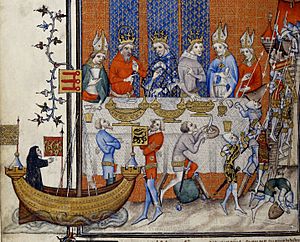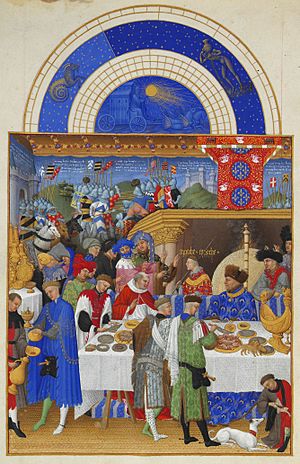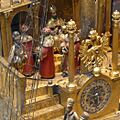Nef (metalwork) facts for kids
Imagine a fancy, ship-shaped decoration for a dining table! That's what a nef was. These amazing objects were popular during the Middle Ages and the Renaissance. They were often made from precious metals like silver or gold. The word nef actually meant 'ship' in French.
Nefs weren't just pretty. They could also hold things like salt, expensive spices, cutlery, or even napkins. Some very large nefs were even used to hold and clean fancy dishes, as seen in old paintings.

What is a Nef?
A nef was a special table decoration shaped like a ship. It was usually made from expensive materials. These included silver, silver-gilt (silver with a thin layer of gold), or even pure gold.
Artists often made nefs even more beautiful. They added colorful enamel and sparkling jewels. Sometimes, a nautilus shell was used to form the ship's hull. This gave the nef a natural, unique look.
How Nefs Changed Over Time
The first nefs appeared in France around 1239. At first, they were simple, just the ship's body. People might have even used them as drinking cups.
By the 1300s, nefs became much more detailed. They had tiny masts, sails, and even little crew figures. These very fancy nefs were often too crowded to hold anything inside. They became purely decorative.
One amazing example is the Mechanical Galleon from the late 1500s. This German nef was also a clock! It had moving figures and played music. You can see it today in the British Museum.

Cool Features of Nefs
Some nefs had small wheels on the bottom. This allowed them to be rolled easily along the table. Other nefs stood on legs or pedestals.
The nef was always placed in front of the most important person at the dinner. It showed everyone how important that guest was.
In churches, there was a similar item called a navicula. This Latin word means 'small ship'. A navicula was a boat-shaped holder for incense.
Images for kids
-
The Burghley Nef, made of silver-gilt and a nautilus shell, from France (1527–28). It is now in the V&A Museum.
-
A close-up of the Mechanical Galleon in the British Museum, Germany, around 1585.
See also
 In Spanish: Nef para niños
In Spanish: Nef para niños




